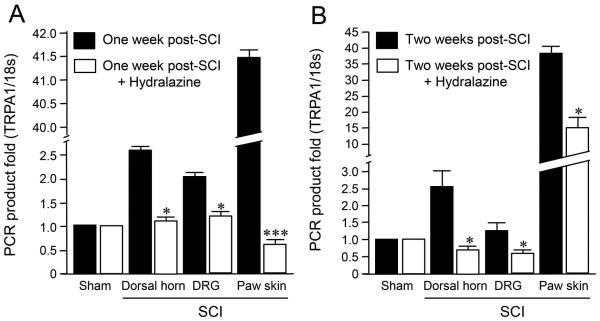Figure 4.
Suppression of TRPA1 mRNA levels by the acrolein scavenger, hydralazine, in various tissues 1 and 2 weeks after injury. A) Suppression of TRPA1 mRNA levels by hydralazine 1 week after injury. Spinal dorsal horn (1 cm long including T10), dorsal root ganglia (DRG, L1-L6), and paw skin were assessed one week after SCI. Specifically, the TRPA1 mRNA levels were significantly increased in dorsal horn, DRG, and paw skin following SCI (P < 0.05 in dorsal horn and DRG, and P < 0.005 in paw skin group when compared to sham). However, this elevated TRPA1 mRNA was significantly attenuated in all three tissue types with the continuous daily IP injection of hydralazine for a week post SCI. (* P<0.05, *** P<0.005 when compared to SCI alone, One-way ANOVA and Tukey test). N=4~8 in each group. All values were expressed as mean ±SEM. B) Suppression of TRPA1 mRNA levels by hydralazine 2 weeks after injury. Specifically, the TRPA1 mRNA levels were significantly increased 2 weeks post SCI in dorsal horn, DRG, and paw skin following SCI (P < 0.05 in dorsal horn, DRG, and P < 0.005 in paw skin group when compared to sham). However, this elevated TRPA1 mRNA was significantly attenuated in all three tissue types with the continuous daily IP injection of hydralazine for 2 weeks post SCI. (* P<0.05, One-way ANOVA and Tukey test). N=4~8 in each group. All values were expressed as mean ±SEM.

